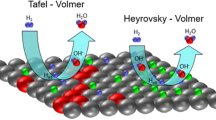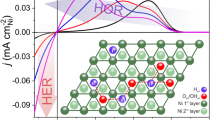Abstract
We have studied the electrochemical properties of electrodes based on the intermetallic TiNi, obtained by powder metallurgy, with an austenite and martensite structure. The electrochemical and capacity characteristics of the electrodes were determined from the charging curve under nonequilibrium conditions, and also from the cyclic voltammetric curve in alkaline medium. We have studied the structural and phase changes during absorption - desorption of hydrogen and the effect of the structure on activation and the hydrogen sorption capacity. We have shown that electrodes made from titanium nickelide with a two-phase structure (austenite, martensite) are easily activated and have a higher hydrogen capacity than electrodes with a single-phase austenite structure.
Similar content being viewed by others
REFERENCES
M. H. Miles, “Evaluation of electrocatalysts for water electrolysis in alkaline solution,” J. Electroanalyt. Chim., 60, No.1, 89–92 (1975).
K. Machida and M. Enyo, “The hydrogen electrode reaction characteristics of thin film electrodes of Ni-based hydrogen storage alloys,” Electrochim. Acta, 29, No.6, 807–815 (1984).
Y. Q. Lee, C. S. Wang, X. G. Yang, and H. G. Pan, “A mathematical model for cycle life of hydride electrodes,” Alloys Comp., 231, No.1–2, 611–615 (1995).
C. S. Wang, Y. Q. Lee, and Q. D. Wang, “Studies of electrochemical properties of TiNi alloy used as MH electrode. 1. Discharge capacity,” Electrochim. Acta, 43, No.21–22, 3193–3207 (1998).
K. Machida, M. Enyo, J. Toyoshima, and K. Miyahara, “Amorphous TiNi and ZrNi alloys for water electrolysis cathode materials,” Bull. Chem. Soc. Jpn., 56, No.11, 3393–3399 (1983).
S. Wanao, Y. Jonemura, M. Nakano, and M. Shimada, “Electrochemical capacities and corrosion of TiNi x and its zirconium substituted alloys hydride electrodes,” J. Less-Comm. Met., 104, 365–373 (1984).
J. Liu, X. Gao, D. Song, and Y. Jang, “The characteristics of the microcapsulated Ti-Ni alloys and their electrodes,” J. Alloys Comp., 231, No.1–2, 852–855 (1995).
C. Jordy, M. Latroche, A. Percheron-Guegan, and J. C. Achard, “Effect of partial substitution in TiNi on its structural and electrochemical hydrogen storage properties,” International Symposium on Metal-Hydrogen Systems: Fundamentals and Application (June 8–12, 1992, Munich), Uppsala, Sweden (1992), p. 1429.
J. Keem, R. Bergeron, and R. Custer, Electrodes Made with Disordered Active Materials and Methods of Making the Same, Pat. 4637967 A1 US, Publ. 1987.
Sh. Wakao, H. Sawa, H. Nakano, and S. Chubachi, “Capacities and durabilities of Ti-Ni alloys hydride electrodes and effects of electrolysis plating on their performances,” J. Less-Comm. Met., 131, No.1–2, 311–319 (1987).
T. Bratanich, S. Solonin, V. Petrischev, and V. Skorokhod, “Dilatation investigation of porous intermetallic samples during reversible hydrogenation,” Int. J. Hydrogen Energy, 21, No.11–12, 1115–1120 (1996).
L. G. Khandros and I. A. Arbuzova, “The martensitic transformation, the memory effect, and superelasticity,” in: Metals, Electrons, and Kinetics [in Russian], Nauk. Dumka, Kiev (1975), pp. 109–143.
I. A. Stepanov, Yu. M. Flomenblit, and V. A. Zaimovskii, “Effect of hydrogen on the temperature of the thermoelastic martensitic transformation in titanium nickelide,” Fizika Metallov i Metallovedenie, 55, No.3, 612–614 (1983).
M. Kh. Shorshov, Yu. M. Flomenblit, S. B. Maslenikov, and N. G. Budigina, “Phase and structural transformations due to hydrogen in alloys based on titanium nickelide,” Fizika Metallov i Metallovedenie, 64, No.3, 498–503 (1987).
H. Bucher, M. A. Gutjahr, and K. D. Beccu, “Hydrogen in intermetallic phases, using the system titanium-nickel-hydrogen as an example,” Z. Metallkunde, 63, No.8, 497–500 (1972).
K. Yamanaka, H. Saito, and S. Semeno, “Formation of hydrides of intermetallic compounds of Ti with Fe, Co, Ni, and Cu,” J. Chem. Soc. Japan Chem. Ind. Chem., No. 8, 1267–1272 (1975).
S. M. Solonin, I. F. Martynova, V. V. Skorokhod, and N. V. Klimenko, “Effect of particle size and morphology on the behavior of titanium nickelide powder during pressing,” Poroshk. Metall., No. 7, 37–41 (1988).
T. Kitamura, C. Iwacyra, and H. Tamya, “Comparative study of LaNi5 type alloy electrodes with and without Pd-plated layer by means of cycling voltammetry,” Electrochim. Acta, 27, 1729–1731 (1982).
Author information
Authors and Affiliations
Additional information
__________
Translated from Poroshkovaya Metallurgiya, Nos. 7–8(444), pp. 99–106, July–August, 2005.
Rights and permissions
About this article
Cite this article
Shcherbakova, L.G., Solonin, S.M., Kolomiets, L.L. et al. Effect of Phase Composition and Activation of a Titanium Nickelide Surface by Electrochemical Cycling on Its Hydrogen Sorption Capacity. Powder Metall Met Ceram 44, 389–395 (2005). https://doi.org/10.1007/s11106-005-0108-0
Received:
Issue Date:
DOI: https://doi.org/10.1007/s11106-005-0108-0




